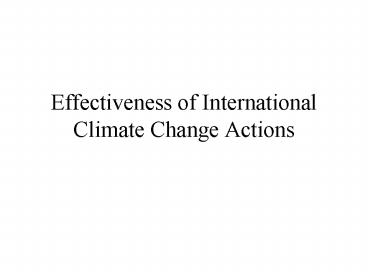Effectiveness of International Climate Change Actions
1 / 25
Title:
Effectiveness of International Climate Change Actions
Description:
McCain/Lieberman Senate Bill. ( Defeated 10/29/03. ... Lieberman McCain Bill: Estimated Cost to Consumers: $10-$20 per year per family. ... – PowerPoint PPT presentation
Number of Views:20
Avg rating:3.0/5.0
Title: Effectiveness of International Climate Change Actions
1
Effectiveness of International Climate Change
Actions
2
The Earth Without Ice?
3
Increasing Carbon-Dioxide
4
The Main Gasses of Concern to the Kyoto Protocol
- Carbon Dioxide (CO2)
- Methane (CH4)
- Nitrous Oxide (N20)
- Hydroflourocarbons (HFCs) (CFC replacement.)
- Perflourcarbons (PFCs) (CFC replacement)
- Sulfur Hexaflouride (SF6)
5
Kyoto Protocol at a standstill
- 55 of pollution required. U.S is 36.1, Russia
is 17.4. - U.S has rejected the treaty. Russia continues to
hesitate to ratify. - Treaty would go into effect if either country
ratified. - Treaty cannot go into effect if both countries
hold out.
6
Russia
- Russia seemed likely to ratify. Economic problems
caused decreases in CO2 emissions. - Russia would be able to sell extra allowable
pollution credits. - However, U.S. rejection means Russias primary
market for sale of credit is no longer in the
system.
7
United States
- George W. Bush rejected CO2 reductions required
by protocol in March 2001. - Referred to incomplete science.
- Referred to economic problems, especially
relating to energy crisis.
8
Other U.S. Reactions to Global Warming
- McCain/Lieberman Senate Bill. (Defeated
10/29/03.) - Maine law requires state CO2 emissions to reach
1990 levels by 2010. - 10 Northeastern State governors agreed to work
together to reduce power plan emissions. - CA, OR, WA agreed to reduce automobile CO2
emissions - 12 states sued the EPA to force it to regulate
CO2.
9
Science and Economic Issues
- Montreal Treaty vs. Kyoto Protocol
- Montreal Treaty dealt with divergent science,
Kyoto deals with competing science. - Economic issues are more severe in global warming
debate than ozone.
10
Emission of CO2 is not fair.
- Developing countries upset that industrial
countries emit so much more. - U.S. Doesnt like Kyotos lack of requirements
for developing countries.
11
Science Issues
- Water Vapor is the most important greenhouse
gas, and is not really effected by man. - Positive feedback loops.
- Urban island debate.
- McIntyre McKitricks recent report criticizing
the 1998 Mann, Bradley Hughes hockey stick
report.
12
Hockey Stick
- Important in the movement against global warming.
13
Hockey Stick Revisited
14
Comparing Costs and Benefits
- Difficult for some nations to see the value of
cooperation. - Some nations could benefit from warming.
- Risks of ozone depletion were more universal and
graphic.
15
Annual Precipitation Trends
16
Costs to Consumers
- Montreal Protocol success partly due to complete
consumer transparency. - Consumers would face much more direct costs and
penalties from global warming law.
17
Example of Costs
- Lieberman McCain Bill Estimated Cost to
Consumers 10-20 per year per family. Original
plan would have cost 30 per year initially,
could have risen up to 400 per year. This bill
is much less restrictive on CO2 than the Kyoto
Protocol. - These costs make for a difficult political sale.
18
Consumer CO2 Emissions
19
Consumer Emissions 2
20
Consumer Emissions 3
21
Replacement Energy Sources
- Current worldwide electricity generation is about
12 trillion watts per second. - 85 is fossil fuel.
- 6.5 nuclear and hydro.
- Less than 2 solar and wind.
22
CO2 is Essentially Clean
- CO2 does not cause disease, is not harmful to
breathe, and is easily broken down. - Compare Nuclear, which releases no greenhouse
gasses. - Compare Aerosols, which may cause global cooling,
but are worse for human health. - Compare HFCs and PFCs to CFCs.
23
Other Replacements
- Ethanol/biomass fuel these do release CO2, but
growing new crops to create new biomass basically
neutralizes the net release. - Clean coal burns coal more efficiently, filters
out some chemicals for fuel cells or industrial
use.
24
Clean Coal
25
Recomendations
- Technology based, rather than emission based
controls as seen in U.S. environmental law,
technology based controls can be more successful
by building in incentives. - Intrinsic value controls eg. Biomass fuels cut
down oil dependence, conserve forest for species
values, etc.































